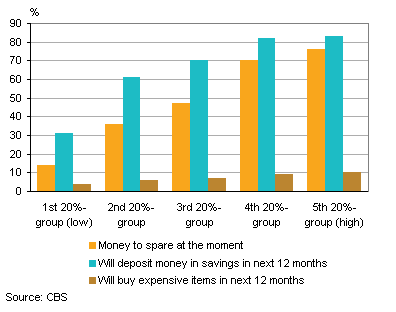Reversal of consumer confidence among highest incomes

Consumer confidence in the Netherlands has fallen substantially in the space of one year: from -5 in the first quarter of 2011 to -36 in the second quarter of 2012. Among people with the highest incomes confidence has switched from predominantly positive to predominantly negative. The same is true for the age group 18-45 years, people with higher education levels and men. In all income groups, more consumers are saving money than buying expensive items.
Confidence at historically low level
Because of among other things the uncertainties surrounding the debt crisis, consumer confidence dropped sharply in the last three quarters of 2011. Confidence fell from -5 in the first quarter to -38 in the fourth, the lowest quarterly value ever. This was the first time ever that such a sharp fall had been recorded in the space of three quarters. In the first quarter of 2012, confidence recovered a little, but at -36 it is still at a historically low level.
Consumer confidence (quarterly figures)

Largest decrease among highest incomes
Consumer confidence is now substantially negative among all groups of consumers. At the beginning of 2011, the highest incomes , 18-45 year-olds, people with higher levels of education and men were still generally positive. The largest decrease in consumer confidence was in the highest income group: from 20 to -23. But among young people, the higher educated and men, too, consumer confidence fell considerably.
From a historical point of view, confidence among higher income groups is always higher than among people with lower incomes. Also, the higher the education level people have, the more positive they are in general. Age correlates negatively: the older consumers are, the lower their confidence usually is. In addition, men are always more positive than women. In the first quarter of 2012, too, these patterns are clearly visible. The differences have become smaller in the last year, however.
Consumer confidence by socio-economic group

Consumers saving instead of spending
Over three-quarters of people with the highest incomes said they had money to spare in the first quarter of this year, compared with 14 percent of people with the lowest incomes. Consumers say they are saving the money they have left over, not spending it on expensive items such as furniture or washing machines. In the most prosperous group, 83 percent of consumers said they were saving their money, while only 10 percent intended to buy expensive goods. In the lowest income groups this was 31 and 4 percent respectively.
Opinion of financial situation by income group, first quarter 2012

Jeroen Nieuweboer